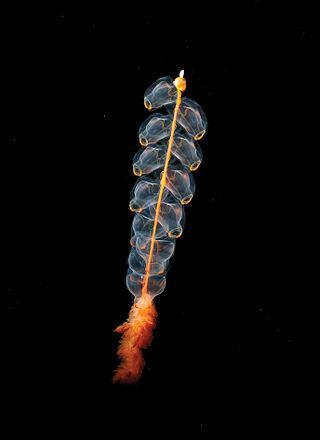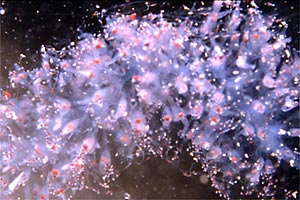
The Portuguese man o' war, also known as the man-of-war, is a marine hydrozoan found in the Atlantic Ocean and the Indian Ocean. It is considered to be the same species as the Pacific man o' war or bluebottle, which is found mainly in the Pacific Ocean. The Portuguese man o' war is the only species in the genus Physalia, which in turn is the only genus in the family Physaliidae.

Hydrozoa is a taxonomic class of individually very small, predatory animals, some solitary and some colonial, most of which inhabit saline water. The colonies of the colonial species can be large, and in some cases the specialized individual animals cannot survive outside the colony. A few genera within this class live in freshwater habitats. Hydrozoans are related to jellyfish and corals and belong to the phylum Cnidaria.

The chondrophores or porpitids are a small group of hydrozoans in the family Porpitidae. Though it derives from an outdated name for this lineage, some still find the term "chondrophore" useful as a synonym to "porpitid" in discussions of the two genera contained therein.

Siphonophorae is an order within Hydrozoa, which is a class of marine organisms within the phylum Cnidaria. According to the World Register of Marine Species, the order contains 175 species thus far.

Physalia is a genus of the order Siphonophorae, colonies of four specialized polyps and medusoids that drift on the surface of the Atlantic, Indian and Pacific oceans. Although these organisms look like a single multicellular organism, each specimen is actually a colony of minute organisms called zooids that have to work together for survival. A gas-filled bladder resembling a blue bottle provides buoyancy, and long tentacles of venomous cnidocytes provide a means of capturing prey. A sail on the float, which may be left or right-handed, propels Physalia about the sea, often in groups. These siphonophores sometimes become stranded on beaches, where their toxic nematocysts can remain potent for weeks or months in moist conditions. Both species of this siphonophore resemble a jellyfish in appearance, with their gas-filled float and cluster of polyps beneath, which can hang up to 30 or 165 feet below the surface of the sea.

Velella is a monospecific genus of hydrozoa in the Porpitidae family. Its only known species is Velella velella, a cosmopolitan free-floating hydrozoan that lives on the surface of the open ocean. It is commonly known by the names sea raft, by-the-wind sailor, purple sail, little sail, or simply Velella.

Praya dubia, the giant siphonophore, is an invertebrate that lives in the deep sea at 700 m (2,300 ft) to 1,000 m (3,300 ft) below sea level. It has been found off the coasts around the world, from Iceland in the North Atlantic to Chile in the South Pacific.

Hydroidolina is a subclass of Hydrozoa and makes up 90% of the class. Controversy surrounds who the sister groups of Hydroidolina are, but research has shown that three orders remain consistent as direct relatives: Siphonophorae, Anthoathecata, and Leptothecata.

Leptothecata, or thecate hydroids, are an order of hydrozoans in the phylum Cnidaria. Their closest living relatives are the athecate hydroids, which are similar enough to have always been considered closely related, and the very apomorphic Siphonophorae, which were placed outside the "Hydroida". Given that there are no firm rules for synonymy for high-ranked taxa, alternative names like Leptomedusa, Thecaphora or Thecata, with or without the ending emended to "-ae", are also often used for Leptothecata.

Marrus is a genus of siphonophores. Species include:

Aequoreidae is a family of hydrozoans, sometimes called the many-ribbed jellies or many-ribbed jellyfish. There are approximately 30 known species found in temperate and tropical marine coastal environments. Aequoreids include Aequorea victoria, the organism from which the green fluorescent protein gene was isolated.

Apolemia is a genus of siphonophores. It is the only genus in the monotypic family Apolemiidae.

Apolemia uvaria, commonly known as string jellyfish, barbed wire jellyfish, and long stringy stingy thingy, is a siphonophore in the family Apolemiidae.

Porpita prunella is a marine species of hydrozoan organisms within the family Porpitidae. It consists of colonies of zooids. Very little is known about this species, as there have been no confirmed sightings since its discovery in 1801 and naming by Haeckel in 1888. Being in the chondrophore group, it is likely that its behaviour is similar to the other species of the genera in the family. However there are also serious doubts as to its very existence as a separate species and may in fact be a synonym for Porpita porpita instead.

Bathyphysa conifera, sometimes called the flying spaghetti monster, is a bathypelagic species of siphonophore in the family Rhizophysidae.

Physonectae is a suborder of siphonophores. In Japanese it is called 胞泳.

Calycophorae is a suborder of Siphonophores alongside two other suborders Physonectae and Cystonectae. This suborder includes the giant siphonophore, ; one of the longest lengthwise extant creatures (40–50m). While the Physonectae have a pneumatophore, nectophore, and a siphosome, Cystonectae lack a nectophore, and Calycophorae lack a pneumatophore. From the bell-shaped nectophores, Physonectae and Calycophorae are called Codonophores or Greek for bell-bearers. The distribution, morphology, and behaviors of Calycophorae species are vast and greatly depend on the species. Calycophoraes typically consist of two nectophores with a siphosome that have many tentacles that grow out of the siphosome. The Calycophoraes move by propelling water out of the nectophore much like how jellyfishes move. The tentacles act as fishing nets where the nematocysts on the tentacles paralyze their prey which are then later fed on. Calycophorae have three life stages, which are the larval development stage, the polygastric stage, and the eudoxid maturation stage. Each Calycophorae colony forms from one fertilized egg.

Abylopsis tetragona is a species of siphonophore in the family Abylidae.
Lensia is a genus of hydrozoans belonging to the order Siphonoporae and the family Diphyidae. This genus is colonial and consists of many different types of highly specialized zooids. The genus Lensia was first established in 1932 by Dr. Arthur Knyvett Totton, who would also describe and add another 11 species during his career. As of March 2023, the genus consists of only 26 described and accepted species and an additional seven uncertain species, according to the World Register of Marine Species.
Tima nigroannulata, commonly known as the elegant jellyfish, is a recently discovered colonial hydrozoa found on the Pacific coast of Japan.
















